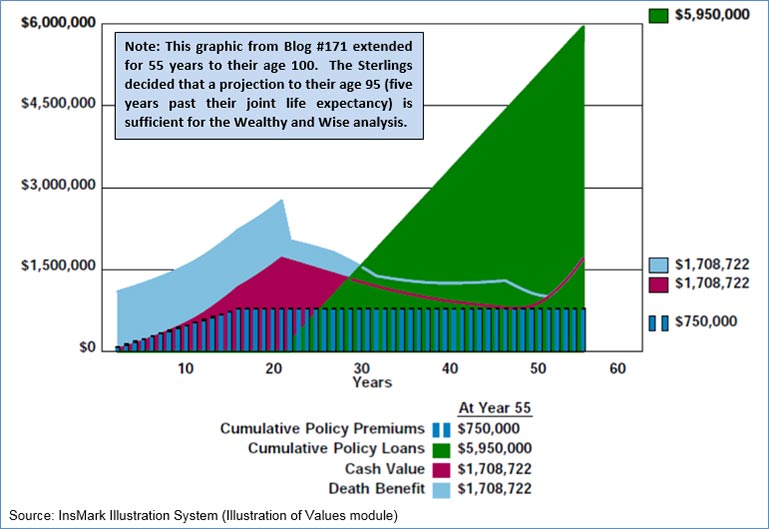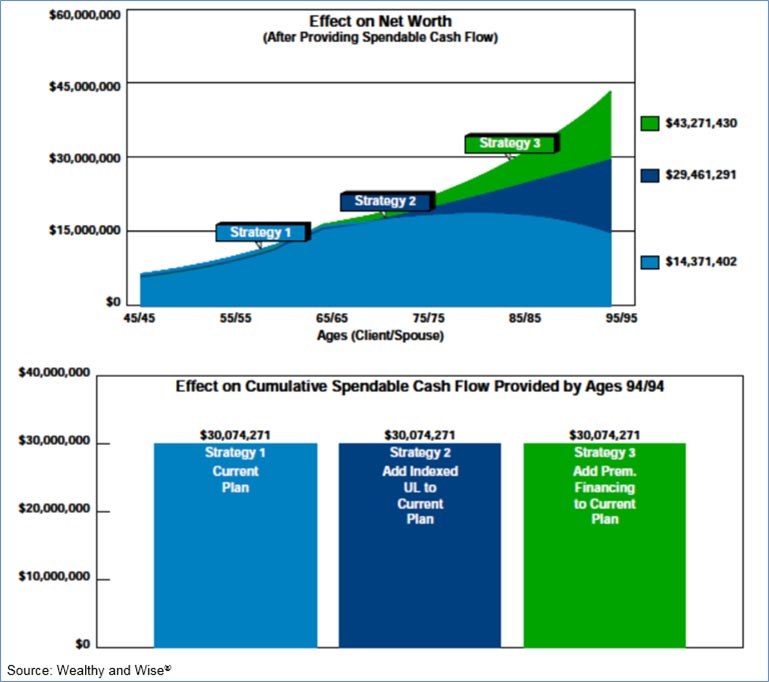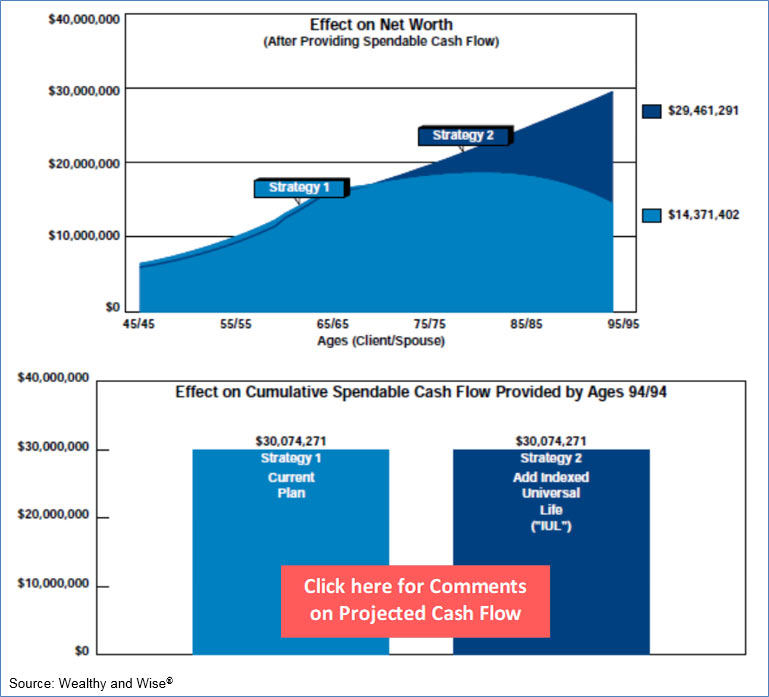(Click here for Blog Archive)
(Click here for Blog Index)
(Presentations in this blog were created using the InsMark® Illustration System, InsMark Premium Financing System and Wealthy and Wise®)

|

In Blog #171: Arbitrage vs. Accelerated Arbitrage (Part 1 of 2), we examined the power of interest rate arbitrage that occurs when participating loans are used with indexed universal life (“IUL”).
Premium financing of IUL has also been a very significant development in the industry. The additional arbitrage caused by funding IUL with bank loans compounds the results considerably, hence the term “Accelerated Arbitrage”.
The long-range consequences of using Accelerated Arbitrage are difficult to appreciate fully unless an overall wealth analysis compares the use of both forms of arbitrage with no arbitrage at all, i.e., no IUL and no premium financing. This InsMark-designed evaluation process is referred to by many as “Compared to What” or “Do-it vs. Don’t Do-it”.
Today, we will examine “Compared to What” by integrating the IUL and premium financing illustration data from Blog #171 (Part 1 of 2) into our Wealthy and Wise® planning system to gauge the impact on cash flow, net worth, and wealth to heirs compared to a client’s current plan.
If you haven’t read Blog #171 (Part 1 of 2), I recommend you do so as it will provide you with key information that will make Part 2 more relevant. Click here if you have read Blog #171 but would like to review a Summary of its features.
Case Study
Robert and Jamie Sterling are both age 45. Based on the new tax reform act, they expect to be in a combined state and federal income tax bracket of 40%. Their combined net worth is $6,600,000 ($1,600,000 in retirement plans, $800,000 in CDs, $800,000 in municipal bonds, $2,500,000 in equities plus $900,000 in home value and personal property).
Click here to review the details of their current net worth.
As background, Image 1 below shows a graphic of the IUL illustration insuring Robert Sterling, age 45, as featured in Blog #171. Face amount is $1,054,069 increasing for 20 years; level thereafter. Premiums are $50,000 a year for 15 years with participating policy loans beginning at age 65.
| Image 1 |
| Illustration of Values |
| (Including the Effect of Arbitrage) |

Click here to review the entire illustration.
Image 2 below shows the impact on their net worth if the IUL reflected in Image 1 is integrated into their overall wealth plan (as calculated by InsMark’s Wealthy and Wise®). The cumulative premiums for the IUL of $750,000 ($50,000 for 15 years) involves withdrawals from their assets, not an out-of-pocket expense.
| Image 2 |
| Effect on Net Worth |
| Strategy 1: Current Plan |
| Strategy 2: Add IUL to the Current Plan |
The IUL more than doubles their net worth with no impact on spendable cash flow.
Accelerated Arbitrage
The IUL’s annual premium for 15 years is increased four times to $200,000 using the minimum possible death benefit of $4,216,273. The Sterlings are scheduled to pay $50,000 of the premium (so the out-of-pocket to them is the same with either IUL variation) with the balance of $150,000 funded by bank loans. Loan interest is accrued. The bank loan and accrued loan interest is repaid at the beginning of year 16 by way of a participating policy loan. Annual, participating, policy loans of $350,000 for retirement cash flow begin at age 65 and are illustrated through age 95, five years past the Sterlings joint life expectancy.
The graphic in Image 3 below summarizes the results of premium financing for the Sterlings after accounting for the repayment of bank loans and accrued loan interest at the beginning of year 16.
| Image 3 |
| Premium Financing Plan |
| (Including the Effect of Accelerated Arbitrage) |

Click here to review the entire premium financing illustration. On Page 4, I highlighted the Sterlings contribution of $50,000 a year, the same as the premium on the smaller IUL policy featured in Image 1. I did this to emphasize the power of the premium financing concept where, for the identical outlay, significant increases cash value and death benefit occur – as shown below in Image 4 (from Blog #171).
| Image 4 |
| Arbitrage vs. Accelerated Arbitrage |

Finally, as shown in Image 5 below, I used our Wealthy and Wise to compare the following scenarios:
- Strategy 1 (the Sterlings current financial plan);
- Strategy 2 (adding IUL to the current plan);
- Strategy 3 (adding premium financing to the current plan).
| Image 5 |
| Effect on Net Worth |
| Strategy 1: Current Plan |
| Strategy 2: Add Indexed UL |
| Strategy 3: Add Premium Financing |

The results of the arbitrage of the IUL and the accelerated arbitrage™ of the IUL-funded premium financing are powerful when viewed in the context of an overall wealth analysis. The IUL added to their current plan more than doubles net worth, and premium financing triples it – all with no additional out-of-pocket cost to the clients as asset allocation is used for premiums and participating policy loans are used to repay the bank loan (including accrued loan interest).
If you are not a Wealthy and Wise licensee but would like to review the 31 key calculation ledgers that provide the numbers for the graphics in this Blog, click here for “Highlights of the Wealth Analysis.pdf” generated by Wealthy and Wise for Robert and Jamie Sterling. That’s not as tedious as you might think as most ledgers extend to two pages due to the number of years in the evaluation.
Wealthy and Wise licensees who want access to all 66 calculation ledgers, click here for “Extensive Details of the Wealth Analysis.pdf”. The system backs up every number shown, and you never know which report you’ll need to have handy to answer the inevitable question, “Where did this number come from?” That’s why I provide access to all of them to you in my Blogs as well as the Digital Workbook Files (see below).
Most Wealthy and Wise users select a few key illustrations for the main report and put the balance in supplemental sections or an Appendix. More elaborate report organization can be accomplished (Table of Contents and Section pages) through use of the following prompt -- which I used for this Blog -- located on the bottom right of the Main Workbook Window:

Conclusion
Accelerated arbitrage produces an extraordinary increase in benefits for the same personal contribution, but it is not a plan for the faint-hearted. Suitability of the two arbitrage variations examined in Blogs #171 and #172 is an important consideration:
- A very conservative client may be unwilling to acquire IUL let alone couple it with a premium financing arrangement.
- A moderate client may welcome IUL for its arbitrage potential but be unwilling to include it in a premium financing arrangement.
- A moderately aggressive or aggressive client may be willing to couple both concepts in search of accelerated arbitrage provided the safety valve discussed below is present.
Safety Valve
With IUL/premium financing coupled as illustrated in Blogs #171 and #172, and assuming a policy with high early cash values is used, termination of the plan mid-stream will likely result in the policy having significant residual cash value (“safety valve”) after repayment of the bank loan. This is further enhanced by the guarantee that negative arbitrage cannot occur due the carrier guarantee that the yield credited to cash values can never go negative regardless of the performance of the selected index.
Creating Similar Presentations
If you would like some help creating customized versions of the presentations in this Blog for your clients, watch the video below on how to download and use InsMark’s Digital Workbook Files.
Files For This Blog
New Zip File Downloaders
Watch the video.
Experienced Zip File Downloaders Download the zip file, open it, and double click the Workbook file name to open it in your InsMark System.
|
Before downloading and reviewing any files, be certain you have installed the most current update to your InsMark Systems. Do this using Live Update available under Help on the main menu bar of the System or this icon on the main menu bar:
Note: If you are viewing this on a cell phone or tablet, the downloaded Workbook file won’t launch in your InsMark Systems. Please forward the Workbook where you can launch it on your PC where your InsMark System(s) are installed. |
If you obtain the Digital Workbook for Blog #172, click here for a guide to the content. It will be invaluable to you.
Licensing InsMark Systems
To license any of the InsMark software products, visit our Product Center online or contact Julie Nayeri at Julien@insmark.com or 888-InsMark (467-6275). Institutional inquiries should be directed to David Grant, Senior Vice President — Sales, at dag@insmark.com or (925) 543-0513.
For help on how to use InsMark software, go to The Quickest Way To Learn InsMark.
Testimonials
“InsMark is the Picasso of the financial services world — their marketing savvy never fails to amaze me.”
Doug Peete, Past President, Top of the Table, InsMark Silver Power Producer®, Overland Park, KS
“Standard premium financing illustrations produce much in the way of great data, but it takes the InsMark Premium Financing System to really present compelling numbers; however, the integration of that data into InsMark’s comparative modules like Various Financial Alternatives and Wealthy and Wise is really what makes premium financing sizzle.”
Chris Jacob, CFP, SFI-Cadeau, St. Louis, MO, InsMark Platinum Power Producer®
“As with all of the InsMark software, InsMark’s Premium Financing System has proven to be an indispensable addition to my ability to show my clients the advantages in using a “Financed Premium” concept to solve their financial needs. Because of this, I was able to close three large financed premium cases easier and faster than ever before. As always, InsMark has delivered again. I encourage all who use Premium Finance as a solution to their clients’ needs to purchase this system. The cost of the system is not an expense, but rather an investment in your business.”
William Moates, Jr., Trilennium Financial Alliance LLC, Fort Smith, AR, InsMark Platinum Power Producer®
“InsMark has created without question the best suite of software for our industry that has ever existed. I personally have been using their software for almost 30 years, and it changed my career. This unique and user friendly software will add many thousands to your income for as long as you’re in business. InsMark makes me look good, and it will you as well.”
Simon Singer, CFP®, CAP®, RFC®, Past President International Forum, InsMark Platinum Power Producer®, Encino, CA
“InsMark” and “Wealthy and Wise” are registered trademarks of InsMark, Inc.
“Accelerated Arbitrage” is a trademark of InsMark, Inc.
Important Note #1: The hypothetical values associated with this Blog assume the nonguaranteed values shown continue in all years. This is not likely, and actual results may be more or less favorable. Life insurance illustrations are not valid unless accompanied by a basic illustration from the issuing life insurance company.
Important Note #2: The information in this Blog is for educational purposes only. In all cases, the approval of a client’s legal and tax advisers must be secured regarding the implementation or modification of any planning technique as well as the applicability and consequences of new cases, rulings, or legislation upon existing or impending plans.
Important Note #3: Many of you are rightly concerned about the potential tax bomb in life insurance that can accidentally be triggered by a careless policyowner when policy loans are present and net cash values are so low that the income tax on the gain on surrender (calculated using gross cash values less basis) is more – often significantly more – than the net cash surrender value.
This lurking tax bomb can be present in all forms of whole life and universal life where policy loans of any type are utilized. It can be avoided, and you, the producer, are key to making sure your clients are aware of how to sidestep it.
A tax bomb can be avoided if the policy is neither surrendered nor allowed to lapse, since the policy death benefit wipes away the income tax liability. The foundation of this special treatment is IRC Section 101. This statute provides that the proceeds of life insurance maturing as a death claim are exempt from federal income tax. This applies to the full death benefit, including any cash value component whether loans exist or not.
Note: It is best if you design the policy with no premiums scheduled after retirement if loans are anticipated in retirement years. This may require higher premiums during pre-retirement years, but a policy with no premiums scheduled is much more tolerable at advanced ages than one with continuous premiums.
Can your clients remember these facts years into the future? If they are incapacitated, will family members understand the issues? It is probably best to file a short note with the policy – something like this (although your compliance officer will likely have preferred language):
If/when you take policy loans on this policy, be sure to talk to your financial adviser before surrendering or lapsing the policy in order to anticipate unexpected tax consequences that may otherwise be avoided.
Does this note make it harder or easier to deliver the policy? It’s harder if you haven’t discussed it with your client; easier if you have. And that’s the point – you should discuss it.
Some life insurance companies have concierge units that monitor loan status at the point of lapse or surrender, and you would be well-advised to select an insurance company with this capacity. To be effective regarding the tax bomb, such carriers need to be proactive in their client relationships, not merely reactive to client inquiries. I hope that ultimately the policyholder service division of all life insurance companies will bring this potential liability to the attention of those surrendering or lapsing policies, particularly those policies with 50% or more of the gross cash value subject to outstanding loans.


